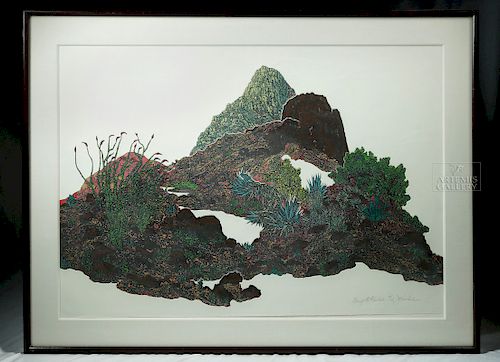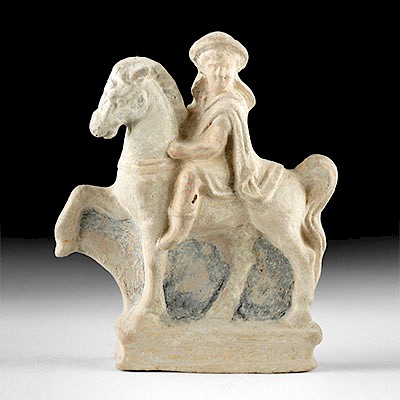Framed J. Solem Viscosity Etching - Grand Canyon
Lot 189
About Seller
Artemis Gallery
686 S Taylor Ave, Ste 106
Louisville, CO 80027
United States
Selling antiquities, ancient and ethnographic art online since 1993, Artemis Gallery specializes in Classical Antiquities (Egyptian, Greek, Roman, Near Eastern), Asian, Pre-Columbian, African / Tribal / Oceanographic art. Our extensive inventory includes pottery, stone, metal, wood, glass and textil...Read more
Estimate:
$1,200 - $1,800
Absentee vs Live bid
Two ways to bid:
- Leave a max absentee bid and the platform will bid on your behalf up to your maximum bid during the live auction.
- Bid live during the auction and your bids will be submitted real-time to the auctioneer.
Bid Increments
| Price | Bid Increment |
|---|---|
| $0 | $25 |
| $300 | $50 |
| $1,000 | $100 |
| $2,000 | $250 |
| $5,000 | $500 |
| $10,000 | $1,000 |
| $20,000 | $2,500 |
| $50,000 | $5,000 |
| $100,000 | $10,000 |
| $200,000 | $20,000 |
About Auction
By Artemis Gallery
May 9, 2019
Set Reminder
2019-05-09 10:00:00
2019-05-09 10:00:00
America/New_York
Bidsquare
Bidsquare : Ancient | Asian | Ethnographic
https://www.bidsquare.com/auctions/artemis-gallery/ancient-asian-ethnographic-4110
Featuring classical antiquities, ancient and ethnographic art from cultures encompassing the globe. All legally acquired, legal to sell. Satisfaction guaranteed. Convenient in-house shipping. Artemis Gallery info@artemisgallery.com
Featuring classical antiquities, ancient and ethnographic art from cultures encompassing the globe. All legally acquired, legal to sell. Satisfaction guaranteed. Convenient in-house shipping. Artemis Gallery info@artemisgallery.com
- Lot Description
John Solem (American, d. 2014), "Along the Kaibab", viscosity etching, signed, titled, and numbered 4/40 in pencil at lower right. Ca. late 20th century. This original, limited edition viscosity etching is from Solem's "Wilderness Spirit" collection and depicts the Kaibab National forest which borders the northern and southern rims of the Grand Canyon in Arizona. By using the viscosity printing process (see more about viscosity printing below) Solem created an image in relief presenting a vivid view of various cacti/succulents and shrubs native to the region - such as Ocatillo with its spiny stems and red flowers at the far left, Agave with its pointed, fleshy leaves throughout the center of the composition, and Gambel Oak with its rambling branches at the far right - as well as the dramatic rock faces in the distance. All is delineated in a striking color palette of claret, burgundy, pink, yellow, sage, spring and kelly greens. Size: 47.125" W x 36.125" H (119.7 cm x 91.8 cm) including custom linen mat and framing. Size: 47.125" W x 36.125" H (119.7 cm x 91.8 cm)
In 2003, John Solem had a solo exhibition at the Kwan Fong Gallery at California Lutheran University. The curators wrote the following, "Solem is a faculty emeritus of the CLU Art Department and a resident of Yosemite Lakes Park north of Fresno. The 'Wilderness Spirit' collection represents his direct experience with nature in Alaska, the High Sierra, the Canadian Wilderness and the Grand Canyon over the last 30 years. His artwork is best actualized through the flow of the sensory experiences with the natural world and shows a deep spiritual relationship between the artist and the wilderness."
Viscosity printing is a sophisticated technique that combines the principles of relief and intaglio printing. It was developed by Stanley William Hayter in Paris in the late 1960s. Viscosity by definition is a fluid's ability to resist flow. The artist can print multiple colors of ink from a single plate instead of using multiple plates to ensure color separation. The artist either scratches or etches a metal plate with acid, and then introduces a viscous ink that possesses the consistency of oil paint into the grooves. Then the polished surface is wiped clean with a cloth and newsprint. Once this is done, the ink only remains below the plate level. Following this, the artist covers the platewith a damp paper and felt blankets and runs it through a press. The immense pressure pushes the paper into the etched grooves to receive the ink. The result is that the ink that was once below the plate's surface is now embossed on the paper to create a relief surface.
Provenance: private Ventura County, California, USA collection
All items legal to buy/sell under U.S. Statute covering cultural patrimony Code 2600, CHAPTER 14, and are guaranteed to be as described or your money back.
A Certificate of Authenticity will accompany all winning bids.
We ship worldwide and handle all shipping in-house for your convenience.
#141722Although this etching has not been examined outside the frame, it appears to be in excellent condition. It is signed, titled, and numbered 4/40 in pencil at lower right. Framing is of museum quality.Condition
- Shipping Info
-
All shipping is handled in-house for your convenience. Your invoice from Artemis Gallery will include shipping calculation instructions. If in doubt, please inquire BEFORE bidding for estimated shipping costs for individual items.
-
- Buyer's Premium



 EUR
EUR CAD
CAD AUD
AUD GBP
GBP MXN
MXN HKD
HKD CNY
CNY MYR
MYR SEK
SEK SGD
SGD CHF
CHF THB
THB
















